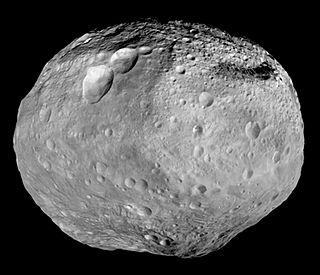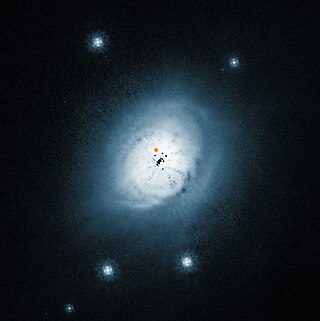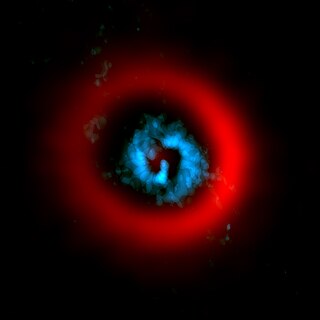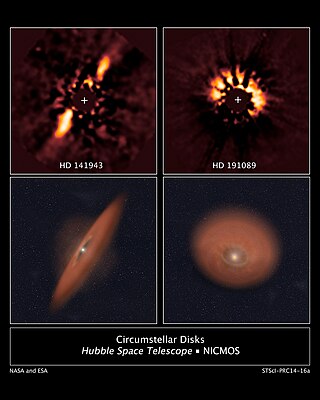Molecular clouds

One of the most obvious manifestations of astrophysical photoevaporation is seen in the eroding structures of molecular clouds that luminous stars are born within. [4]
Photoevaporation is the process where energetic radiation ionises gas and causes it to disperse away from the ionising source. The term is typically used in an astrophysical context where ultraviolet radiation from hot stars acts on clouds of material such as molecular clouds, protoplanetary disks, or planetary atmospheres. [1] [2] [3]

One of the most obvious manifestations of astrophysical photoevaporation is seen in the eroding structures of molecular clouds that luminous stars are born within. [4]
Evaporating Gaseous Globules or EGGs were first discovered in the Eagle Nebula. These small cometary globules are being photoevaporated by the stars in the nearby cluster. EGGs are places of ongoing star-formation. [5]
A planet can be stripped of its atmosphere (or parts of the atmosphere) due to high energy photons and other electromagnetic radiation. If a photon interacts with an atmospheric molecule, the molecule is accelerated and its temperature increased. If sufficient energy is provided, the molecule or atom may reach the escape velocity of the planet and "evaporate" into space. The lower the mass number of the gas, the higher the velocity obtained by interaction with a photon. Thus hydrogen is the gas which is most prone to photoevaporation.
Photoevaporation is the likely cause of the small planet radius gap. [6]
Examples of exoplanets with an evaporating atmosphere are HD 209458 b, HD 189733 b and Gliese 3470 b. Material from a possible evaporating planet around WD J0914+1914 might be responsible for the gaseous disk around this white dwarf.

Protoplanetary disks can be dispersed by stellar wind and heating due to incident electromagnetic radiation. The radiation interacts with matter and thus accelerates it outwards. This effect is only noticeable when there is sufficient radiation strength, such as coming from nearby O and B type stars or when the central protostar commences nuclear fusion.
The disk is composed of gas and dust. The gas, consisting mostly of light elements such as hydrogen and helium, is mainly affected by the effect, causing the ratio between dust and gas to increase.
Radiation from the central star excites particles in the accretion disk. The irradiation of the disk gives rise to a stability length scale known as the gravitational radius (). Outside of the gravitational radius, particles can become sufficiently excited to escape the gravity of the disk, and evaporate. After 106 – 107 years, the viscous accretion rates fall below the photoevaporation rates at . A gap then opens around , the inner disk drains onto the central star, or spreads to and evaporates. An inner hole extending to is produced. Once an inner hole forms, the outer disk is very rapidly cleared.
The formula for the gravitational radius of the disk is [7]
where is the ratio of specific heats (= 5/3 for a monatomic gas), the universal gravitational constant, the mass of the central star, the mass of the Sun, the mean weight of the gas, Boltzmann constant, is the temperature of the gas and AU the Astronomical Unit.
If we denote the coefficient in the above equation by the Greek letter then
, .
where is the number of degrees of freedom and we have used the formula: .
For an atom, such as a hydrogen atom, then , because an atom can move in three different, orthogonal directions. Consequently, . If the hydrogen atom is ionized, i.e., it is a proton, and is in a strong magnetic field then , because the proton can move along the magnetic field and rotate around the field lines. In this case, . A diatomic molecule, e.g., a hydrogen molecule, has and . For a non-linear triatomic molecule, such as water, and . If becomes very large, then approaches zero. This is summarised in the Table 1 , where we see that different gases may have different gravitational radii.
| Particle | ||
| H+ in a B field | 2 | 0.25 |
| H | 3 | 0.2 |
| H2 | 5 | ~ 0.143 |
| H2O | 6 | 0.125 |
| Limiting case | ∞ | 0 |
Table 1: Gravitational radius coefficient as a function of the degrees of freedom.
Because of this effect, the presence of massive stars in a star-forming region is thought to have a great effect on planet formation from the disk around a young stellar object, though it is not yet clear if this effect decelerates or accelerates it.
The most famous region containing photoevaporated protoplanetary disks is the Orion Nebula. They were called bright proplyds and since then the term was used for other regions to describe photoevaporation of protoplanetary disks. They were discovered with the Hubble Space Telescope. [8] There might even be a planetary-mass object in the Orion Nebula that is being photoevaporated by θ1 Ori C. [9] Since then HST did observe other young star clusters and found bright proplyds in the Lagoon Nebula, [10] the Trifid Nebula, [11] Pismis 24 [12] and NGC 1977. [13] After the launch of the Spitzer Space Telescope additional observations revealed dusty cometary tails around young cluster members in NGC 2244, IC 1396 and NGC 2264. These dusty tails are also explained by photoevaporation of the proto-planetary disk. [14] Later similar cometary tails were found with Spitzer in W5. This study concluded that the tails have a likely lifetime of 5 Myrs or less. [15] Additional tails were found with Spitzer in NGC 1977, [13] NGC 6193 [16] and Collinder 69. [17] Other bright proplyd candidates were found in the Carina Nebula with the CTIO 4m and near Sagittarius A* with the VLA. [18] [19] Follow-up observations of a proplyd candidate in the Carina Nebula with Hubble revealed that it is likely an evaporating gaseous globule. [20]
Objects in NGC 3603 and later in Cygnus OB2 were proposed as intermediate massive versions of the bright proplyds found in the Orion Nebula. [21] [22]

The Orion Nebula is a diffuse nebula situated in the Milky Way, being south of Orion's Belt in the constellation of Orion, and is known as the middle "star" in the "sword" of Orion. It is one of the brightest nebulae and is visible to the naked eye in the night sky with apparent magnitude 4.0. It is 1,344 ± 20 light-years (412.1 ± 6.1 pc) away and is the closest region of massive star formation to Earth. The M42 nebula is estimated to be 24 light-years across. It has a mass of about 2,000 times that of the Sun. Older texts frequently refer to the Orion Nebula as the Great Nebula in Orion or the Great Orion Nebula.

The nebular hypothesis is the most widely accepted model in the field of cosmogony to explain the formation and evolution of the Solar System. It suggests the Solar System is formed from gas and dust orbiting the Sun which clumped up together to form the planets. The theory was developed by Immanuel Kant and published in his Universal Natural History and Theory of the Heavens (1755) and then modified in 1796 by Pierre Laplace. Originally applied to the Solar System, the process of planetary system formation is now thought to be at work throughout the universe. The widely accepted modern variant of the nebular theory is the solar nebular disk model (SNDM) or solar nebular model. It offered explanations for a variety of properties of the Solar System, including the nearly circular and coplanar orbits of the planets, and their motion in the same direction as the Sun's rotation. Some elements of the original nebular theory are echoed in modern theories of planetary formation, but most elements have been superseded.

A protoplanetary disk is a rotating circumstellar disc of dense gas and dust surrounding a young newly formed star, a T Tauri star, or Herbig Ae/Be star. The protoplanetary disk may also be considered an accretion disk for the star itself, because gases or other material may be falling from the inner edge of the disk onto the surface of the star. This process should not be confused with the accretion process thought to build up the planets themselves. Externally illuminated photo-evaporating protoplanetary disks are called proplyds.

A proplyd, short for ionized protoplanetary disk, is an externally illuminated photoevaporating protoplanetary disk around a young star. Nearly 180 proplyds have been discovered in the Orion Nebula. Images of proplyds in other star-forming regions are rare, while Orion is the only region with a large known sample due to its relative proximity to Earth.

A protoplanet is a large planetary embryo that originated within a protoplanetary disk and has undergone internal melting to produce a differentiated interior. Protoplanets are thought to form out of kilometer-sized planetesimals that gravitationally perturb each other's orbits and collide, gradually coalescing into the dominant planets.

A rogueplanet, also termed a free-floating planet (FFP) or an isolated planetary-mass object (iPMO), is an interstellar object of planetary mass which is not gravitationally bound to any star or brown dwarf.

A satellite galaxy is a smaller companion galaxy that travels on bound orbits within the gravitational potential of a more massive and luminous host galaxy. Satellite galaxies and their constituents are bound to their host galaxy, in the same way that planets within our own solar system are gravitationally bound to the Sun. While most satellite galaxies are dwarf galaxies, satellite galaxies of large galaxy clusters can be much more massive. The Milky Way is orbited by about fifty satellite galaxies, the largest of which is the Large Magellanic Cloud.

Sh2-279 is an HII region and bright nebulae that includes a reflection nebula located in the constellation Orion. It is the northernmost part of the asterism known as Orion's Sword, lying 0.6° north of the Orion Nebula. The reflection nebula embedded in Sh2-279 is popularly known as the Running Man Nebula.

The Flame Nebula, designated as NGC 2024 and Sh2-277, is an emission nebula in the constellation Orion. It is about 1350 light-years away. At that distance, the Flame Nebula lies within the Orion B cloud of the larger Orion Molecular Cloud Complex.

NGC 2244 is an open cluster in the Rosette Nebula, which is located in the constellation Monoceros. This cluster has several O-type stars, super hot stars that generate large amounts of radiation and stellar wind.

HD 100546, also known as KR Muscae, is a pre-main sequence star of spectral type B8 to A0 located 353 light-years from Earth in the southern constellation of Musca. The star is surrounded by a circumstellar disk from a distance of 0.2 to 4 AU, and again from 13 AU out to a few hundred AU, with evidence for a protoplanet forming at a distance of around 47 AU.

AB Aurigae is a young Herbig Ae star in the Auriga constellation. It is located at a distance of approximately 531 light years from the Sun based on stellar parallax. This pre-main-sequence star has a stellar classification of A0Ve, matching an A-type main-sequence star with emission lines in the spectrum. It has 2.4 times the mass of the Sun and is radiating 38 times the Sun's luminosity from its photosphere at an effective temperature of 9,772 K. The radio emission from the system suggests the presence of a thermal jet originating from the star with a velocity of 300 km s−1. This is causing an estimated mass loss of 1.7×10−8 M☉ yr−1.

The Lambda Orionis Cluster is an open star cluster located north-west of the star Betelgeuse in the constellation of Orion. It is about five million years old and roughly 1,300 ly (400 pc) away from the Sun. Included within the cluster is a double star named Meissa. With the rest of Orion, it is visible from the middle of August in the morning sky, to late April before Orion becomes too close to the Sun to be seen well. It can be seen from both the northern hemisphere and the southern hemisphere.

Cometary knots, also referred as globules, are structures observed in several nearby planetary nebulae (PNe), including the Helix Nebula, the Ring Nebula, the Dumbbell Nebula, the Eskimo Nebula, and the Retina Nebula. They are believed to be a common feature of the evolution of planetary nebulae, but can only be resolved in the nearest examples. They are generally larger than the size of the Solar System, with masses of around 0.00001 times the mass of the Sun, which is comparable to the mass of the Earth. There are about 40,000 cometary knots in the Helix Nebula.

HD 259431 is a young stellar object in the constellation of Monoceros.

A circumstellar disc is a torus, pancake or ring-shaped accretion disk of matter composed of gas, dust, planetesimals, asteroids, or collision fragments in orbit around a star. Around the youngest stars, they are the reservoirs of material out of which planets may form. Around mature stars, they indicate that planetesimal formation has taken place, and around white dwarfs, they indicate that planetary material survived the whole of stellar evolution. Such a disc can manifest itself in various ways.
In planetary science a streaming instability is a hypothetical mechanism for the formation of planetesimals in which the drag felt by solid particles orbiting in a gas disk leads to their spontaneous concentration into clumps which can gravitationally collapse. Small initial clumps increase the orbital velocity of the gas, slowing radial drift locally, leading to their growth as they are joined by faster drifting isolated particles. Massive filaments form that reach densities sufficient for the gravitational collapse into planetesimals the size of large asteroids, bypassing a number of barriers to the traditional formation mechanisms. The formation of streaming instabilities requires solids that are moderately coupled to the gas and a local solid to gas ratio of one or greater. The growth of solids large enough to become moderately coupled to the gas is more likely outside the ice line and in regions with limited turbulence. An initial concentration of solids with respect to the gas is necessary to suppress turbulence sufficiently to allow the solid to gas ratio to reach greater than one at the mid-plane. A wide variety of mechanisms to selectively remove gas or to concentrate solids have been proposed. In the inner Solar System the formation of streaming instabilities requires a greater initial concentration of solids or the growth of solid beyond the size of chondrules.

A circumplanetary disk is a torus, pancake or ring-shaped accumulation of matter composed of gas, dust, planetesimals, asteroids or collision fragments in orbit around a planet. They are reservoirs of material out of which moons may form. Such a disk can manifest itself in various ways.
A Peter Pan disk is a circumstellar disk around a star or brown dwarf that appears to have retained enough gas to form a gas giant planet for much longer than the typically assumed gas dispersal timescale of approximately 5 million years. Several examples of such disks have been observed to orbit stars with spectral types of M or later. The presence of gas around these disks has generally been inferred from the total amount of radiation emitted from the disk at infrared wavelengths, and/or spectroscopic signatures of hydrogen accreting onto the star. To fit one specific definition of a Peter Pan disk, the source needs to have an infrared "color" of , an age of >20 Myr and spectroscopic evidence of accretion.